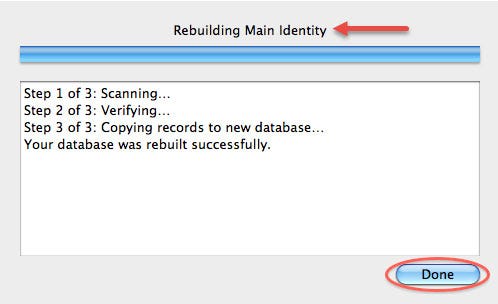My Outlook 2011 For Mac Keeps Needing To Rebuild Its Database
Posted : admin On 05.02.2019Outlook for Mac 2011 vs Mail - Which is better? Discussion in 'Mac Apps and Mac App Store' started. With Entourage, I never had the same confidence. In any event, I would then have to repair and rebuild the database. I tried Outlook for the Mac when it was introduced. (office for mac 2011 is the only thing on my system that ever gives me. Note: The ability to manually repair or rebuild a database is not available in Outlook 2016 for Mac.If a problem such as Outlook data corruption occurs, Office 2016 for Mac automatically repairs and rebuilds the Office database for you. For more information, see About the Office 2016 for Mac database. Apr 16, 2018 The Outlook database and data records are stored in the Office 2011 Identities folder. By moving the folder to the desktop, Outlook will automatically create a new database. If Outlook opens without a problem, we will have to troubleshoot the Outlook database.
Recently, after selecting to do a search in Microsoft Outlook, I got a “No Results” message. I was certain the email I was seeking existed in the folder I was searching.
So I did a few tests. Sure enough, I discovered that any search I now attempted came back with “No Results.” Uh-oh. This led me to check Microsoft’s Answers site. Here I found. This, in turn, led to another helpful. The postings on these pages contained several potential solutions. While no one solution worked for everyone, there was agreement as to the most likely road to success.
It’s a road that may surprise you: Outlook depends on OS X’s Spotlight database for its searches. Therefore, anything that causes problems between Spotlight and Outlook may prevent Outlook’s searches from succeeding. The top recommended solution is to re-index the relevant Outlook data in Spotlight. To do this: 1.

Open System Preferences and select the Spotlight pane. Click the Privacy tab. From the Finder, go to your Home directory -> Documents -> Microsoft User Data folder. Locate a subfolder named Office 2011 Identities. Drag the Identities folder to the Privacy window. This adds the folder to the Privacy list, which means Spotlight will not search this folder in the future. But this is not your goal.
You want the opposite. So Click to remove the Identities folder from Spotlight’s Privacy list. From the Privacy window, select the newly added Identities folder. Then click the minus (-) button near the bottom left of the window. This removes the folder from the list. On the surface, this appears to have accomplished nothing; you just undid a change you made a moment before. However, it should the Identities folder.
If there was a problem with Spotlight and the data in this folder, the re-index will hopefully fix it. This worked for me. You can track the progress of re-indexing by selecting the Spotlight menu bar item.
The reindexing time should be relatively brief in the above case. However, if the time appears so brief that you suspect no re-indexing was done at all, and if the search problem thus remains, you can force a re-index of your entire drive.  To do so, launch Terminal and type: sudo mdutil -E / Enter your admin password when requested. As this re-indexes everything on your drive, prepare to wait awhile. Depending upon the size of your drive and the data on it, you may have to wait several hours.
To do so, launch Terminal and type: sudo mdutil -E / Enter your admin password when requested. As this re-indexes everything on your drive, prepare to wait awhile. Depending upon the size of your drive and the data on it, you may have to wait several hours.
Once the re-indexing is over, Outlook searches should work again. If not, the aforementioned threads offer a few other potential fixes. One user claimed that, before re-indexing would work, he had to first delete a backup copy of his main Identity folder. Another user reported success by moving the entire Office 2011 Identities folder from its default location to the Desktop and then moving it back again.
A trio of Quick Fixes Not content to solve just one problem per column, I offer quick fixes to a trio of other matters you may confront: Get old versions of Flash Player to work with Safari 5.1.7. The just-released disables all out-of-date versions of Adobe Flash Player as part of its installation process. However,, it is still capable of working with the older versions (if you prefer not to get the latest Player for some reason). To re-activate a previously installed Player, go to the root level Library folder on your drive and locate the “Internet Plug-Ins (Disabled)” folder. From within this folder, find Flash Player.plugin and drag it to the “Internet Plug-Ins” folder in the same Library folder. Quit Safari and restart it. Problems after using “Apply to enclosed items” If you select Get Info (Command-I) for a folder in the Finder, and select the Action menu at the bottom, you’ll find a command called “Apply to enclosed items” If you make any changes to the Sharing & Permissions section, you can use this command to apply the changes to all items within the folder (as opposed to just the selected folder itself).